Thanks for joining me this week! We’ve got two big things to cover: the M14 Prerelease and the follow up to The Guildpact, a contest from two weeks ago where you, the reader, made a super fun Prismatic deck. As Evan Erwin says, let’s go!
M14 Prerelease
M14’s proverbial cat is out of the bag, and to celebrate the occasion I did something a little different. Instead of treading up to my local shop for a brew with people I know, I decided to go somewhere I’d never been to see people I’d never met. On a bit of a wild hair and with the desire to see the mother store, if you will, I packed up my VW Beetle and zipped through two states to visit the Star City Game Center in Roanoke, Virginia.
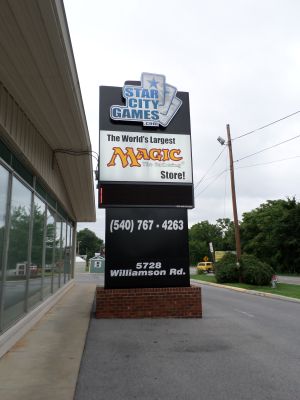
A couple years ago, I found this place on Google Maps and kind of wondered what it was like. I’d always wanted to drop by (as much as an afternoon’s drive is a "drop by" kind of thing) and check the place out, maybe meet some of the personalities I see when I watch the SCG Open Series. Either way, I finally drew Opportunity and set out to traverse the mountains of West Virginia to visit for a day.
I’d read/viewed the spoiler, prepped my Cube upgrades, and fiddled with new and revised Standard lists, but what kind of things would M14 Limited deliver? I plotted decks the whole drive down. Wind, rain, and even a rainbow accompanied me for a while along the 400-mile journey. Listening to music, getting my thoughts together, and enjoying the mountain drive was a really nice break.
Finally, I arrived.
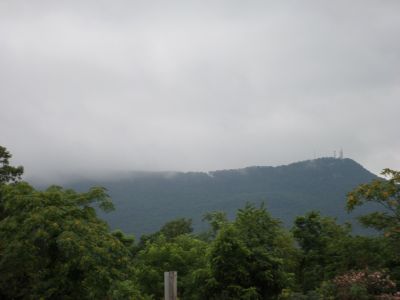
After a good night’s sleep and a hearty breakfast, I felt as ready as I’d ever be to take on the local talent and rub shoulders with the big players of our community. The 10 AM start time is the most honest tournament start I’ve ever seen, and just a couple minutes after the hour we were all seated and ready. I rolled out my mat, made my usual small talk with my neighbors, and nervously shuffled my boosters in my hands while the judges reminded us all of the Sealed rules for building and play.
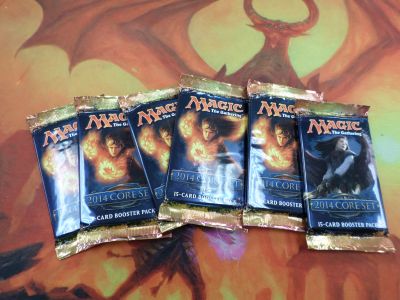
Check out my six packs.
We were given our half hour to build, and I was off. I ripped, sorted, exclaimed, and laughed as I piled my pulls by color, finding a couple clutch rares and a surprisingly level of synergy and consistency in the pool. Nearly every color was deep in one way or another, and each had modest creature and removal options.
I hadn’t thought ahead about which colors I thought would be the best together or even best alone. While I normally analyze each set when it’s released, I’d gotten lazy and neglected to do so for this event. Fortunately, I had two good decks presented to me, and both saw their fair share of play over the next four rounds. With a bit of a Sliver package and solid removal and evasion, I swooped into Izzet colors to build the first deck.
Creatures (14)
- 2 Canyon Minotaur
- 2 Pitchburn Devils
- 1 Archaeomancer
- 2 Blur Sliver
- 1 Striking Sliver
- 1 Goblin Diplomats
- 1 Trained Condor
- 1 Warden of Evos Isle
- 1 Elite Arcanist
- 1 Galerider Sliver
- 1 Dragon Egg
Lands (17)
Spells (9)

This deck was fast, fun, and relatively effective. In round 1, Josh (I believe it was) thought the color combination also looked enjoyable. We played a mirror match, matching Blur Sliver, Disperse, and Shock without missing a beat. Before long, though, I was able to amass enough evasion in both games to keep me ahead in the race.
After a kind concession from Josh, I set to building the other deck my pool afforded me. While less consistent in power level, the cards my second deck supported were, frankly, bananas. I didn’t have time to build it before time was called, so I took the chance now. Over the course of the next three rounds, I switched and started with each deck in turn.
Creatures (15)
- 1 Wall of Swords
- 1 Suntail Hawk
- 1 Capashen Knight
- 2 Griffin Sentinel
- 1 Siege Mastodon
- 1 Archangel of Thune
- 1 Corpse Hauler
- 1 Deathgaze Cockatrice
- 1 Undead Minotaur
- 2 Banisher Priest
- 1 Lifebane Zombie
- 2 Blood Bairn
Lands (17)
Spells (8)

About the black Staff, the "Lucky Charm," I couldn’t resist complementing Archangel of Thune, so sue me. I’m still a synergy junkie, after all.
My second round, against the gracious and formidable deckbuilding skills of William, was sorely not in my favor. After trading blows for a bit, his Izzet deck produced Colossal Whale. With my Disperse and Essence Scatters nowhere in sight, my team was quickly engulfed by the unblockable Whale, and I lowered the anchor. In a first untested attempt, I brought in my reserve Orzhov deck for game 2. My interaction level was terrible against the Whale, and if I didn’t have a counter, I was just flat dead to it. However, a mulligan to five revealed three one-land hands for game 2, and after drawing nothing but a Plains and a Pacifism, I was dead again.
Mana screw thankfully is a fairly infrequent visitor to my games, but this one hurt. William was kind and gracious, sharing a nail-biting, fortuitous story from the previous evening’s release about casting Act of Treason on a Fireshrieker equipped Kalonian Hydra and swinging back for the win.
Then came round 3. I fear I can’t recall my opponent’s name. Joseph perhaps? I apologize.
I still tried to stumble in with the Izzet deck, and he trounced me game 1 with black and green spells and beats. I tried the Orzhov deck again, and it delivered. Banisher Priest and Lifebane Zombie made quick work of his deck, and Archangel of Thune is pretty good too. He said he preferred the black and white deck, but I wasn’t sold.
Finally, round 4 brought my opponent Kevin to the table. A fun, joking kind of fellow, he enjoyed a bit of banter despite the pronounced intensity of our game. In game 1, he assembled Simic monsters and a lot of mana to power out Air Servants and Woodborn Behemoth sized threats. What his deck lacked in removal it made up in power.
In game 2, I curved out perfectly into the Archangel of Thune, and there was nothing he could do.
Game 3 was a tightly run race where Air Servant proved to be a dominating force. Whacking me for four a turn and disabling my air force turn after turn was backbreaking. Although I resolved Archangel, he landed the Servant a turn later, and she never got in there. I sat at five lands for turn after turn, my lonely Corrupt decaying in my hand. I never drew the fifth land; he tapped down my Suntail Hawk and various other blockers and brought everything, even his mana dorks, into the red zone. My ground team couldn’t keep up, and I succumbed to exactsies.
2-2
I’m still not sure which deck is better; I could see the argument for either, but this is the most I’ve played two different Sealed decks in the same event, so I enjoyed that aspect a lot.
Although I wished to participate in the Two-Headed Giant tournament, I could not find a partner in time, and it was for the best. With a long drive ahead, I would have been getting home into the wee hours if I wanted to jam it all in.
Instead, I took a moment to meet up with my boss and semi-Magic role model, Cedric Phillips.

He came by to spellsling all day Saturday and Sunday, building a Sealed deck just like us and battling for booster packs. Having never met the man in the flesh, I sat down, introduced myself, and battled using my Orzhov deck. He also had suited up with the black and white, but his deck was packed to the brim with a very sturdy enchantment theme. Blightcaster, Ajani’s Chosen, Auramancer, and two or three of both Pacifism and Quag Sickness made life difficult for most of his opponents, myself included.
After getting back in line and getting the last pieces for my Cube update, I got to sit down with Cedric for a few in a row, this time with my Izzet deck. It fared much better, and the Slivers proved their might. Using this deck, we traded blows, getting two games each. Really an upstanding Magic player and human being, and I highly recommend you share a moment and the battlefield with him if you get the chance in the future. Don’t be shy, Cedric, let this bit of gushing through.
He battled with plenty of townies too.
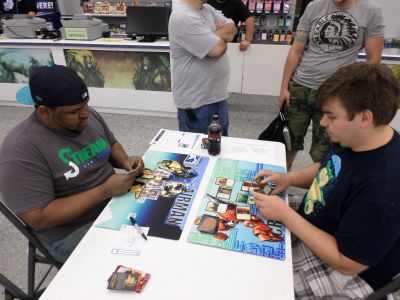
Todd Anderson, folks.
Having stayed to do everything I came for, I slid away, happy with a fun day of Sealed Magic and some chatting with pros. I was really impressed with the high quality player base the mother store had to offer; each player there was excited about Magic and had stories to tell, friendly advice to offer, and good spirit to share with their friends and their opponents. It’s not that I was expecting it, but I think it’s tempting for us to believe that the upper echelons of any gaming environment, Magic or otherwise, are populated with rude, overzealous Spikes eager only to add to the left side of their game record. The Game Center was filled with high-caliber, analytical Magic players that openly and comfortably shared deck ideas, stories, and experiences.
Now for the long drive back.

A bit of curvy driving, a jaunt across a toll road, and a final bend towards home were the only things between me and a good night’s sleep after a full day of Magic. I left satisfied with the events of the day and with my experience at the shop. I recalled the good plays, relived play mistakes, and tried to analyze the M14 Sealed format as a whole. While four rounds and one pool is hardly enough to base a firm opinion on, here’s my thoughts about this format at first blush condensed into three bite-size chunks.
1. Naturalize and Disperse are actual removal spells.
Due to the enchantment-heavy nature of this set, most every deck that doesn’t rely on big green bruisers will rely on some means of performance-enhancing Auras to get the job done. Similarly, a lot of removal resides in this spell type, so think of these two spells as legitimate combat tricks. Stripping a Fireshrieker from an attacking weakling can quickly evolve into a two-for-one, and nearly every deck will be playing one. You might take it out, but I’m pretty sure that will not happen very often.
2. Five is the magic number.
Both in power and toughness, five is very challenging to break through. Siege Mastodon, a "meh" card in most every core set it’s seen, was an actual house for me. Even the three power was passable. Chandra’s Outrage, a successful Newt sacrifice, and most creatures slip away at the four mark, so even if it’s inefficient or off color, play at least one or two X/5s or 5/Xs.
3. Slivers hurt.
Very little can touch a Sliver deck. While it’s harder to make this archetype happen in Sealed, bear it in mind for Draft. Nearly every Sliver is at least playable by itself; just think of analogous predecessors. Blur Sliver is Goblin Chariot, Predatory Sliver (one of, if not the only, common lord in Magic) is a Grizzly Bears, and Bonescythe Sliver is a Kinsbaile Cavalier. This makes them good in any deck, but mixing them together will make for a terrifying concoction.
I’m not sure what the critical mass for Slivers is, but I played five in my Izzet deck and that was enough. Who knows what happens if you get ten or more? I’ve even brewed up a Sliver deck for Standard, which I’ll share next week for your hive-mind thinkers. Suffice it to say that as a set mechanic this one is a lot of fun. Slivers are a very emotional topic for a lot of Sliver lovers, good or bad, but this is a well-executed reintroduction of the beloved creature type.
From what I’ve gathered from my fellow Magic comrades, the jury’s still out on the quality and funness of M14 in Limited, but I had a good time. This is a simple, utilitarian set; it isn’t filled with the pizzazz and panache of some previous core sets, but it is, how do you say, intuitive. This tests basic knowledge of the game with both simple and complex scenarios; everything works exactly like you’d expect it to, the interactions aren’t subtle, and the player is rewarded for both good plays and, more importantly, with deck construction. The power level of this set is too low to entice a lot of players, but if you give it a chance, I know you’ll be happy to come back and play it again.
Core sets are among my favorite Limited formats—M12 and Tenth Edition being my favorites—and M14 is a solid set for those looking to dig into the Limited game. I can pretty well guess that drafting this set over and over will result in more improvement too. Return to Ravnica Block is a very fun Draft format, one of the best in a while I’d say, but it’s tougher to get a consistent deck time and time again and it was in the single sets too. I think M14 will be a great test for green Limited players to cut their teeth and learn the ins and outs of the 40-card format.
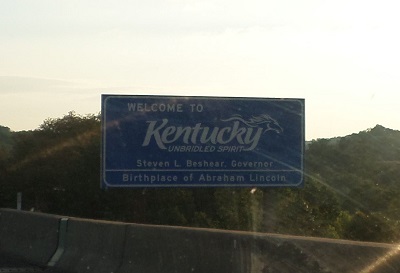
I’m glad I went down, and I hope the opportunity to travel for Magic presents itself in the future soon. I enjoy both travel and Magic, so putting them together makes me a happy camper.
The Guildpact
Two weeks ago, I asked for deck submissions following some specific guidelines: build a Standard deck that uses at least two and no more than eight gold cards of each multicolor combination and artifacts to make a fun and effective deck for casual/local play. First, I want to thank all of you for your submissions. You made me think and laugh at the same time. Your insightfulness was impressive, and each of you had great ideas to contribute. It was tricky to pare down the best decks, but I’m going to share two with you that I like and then the deck I made myself to attack the format.
We Are The World City Of Guilds by Jeff Chinn
3 Godless Shrine
2 Kessig Wolf Run
2 Sacred Foundry
2 Blood Crypt
2 Overgrown Tomb
2 Breeding Pool
2 Hinterland Harbor
2 Temple Garden
1 Isolated Chapel
1 Clifftop Retreat
1 Dragonskull Summit
1 Woodland Cemetery
1 Hallowed Fountain
1 Steam Vents
1 Sulfur Falls
1 Rootbound Crag
2 Domri Rade
2 Izzet Charm
2 Sphinx’s Revelation
4 Wojek Halberdiers
4 Spike Jester
4 Tithe Drinker
4 Loxodon Smiter
3 Varolz, the Scar-Striped
2 Lotleth Troll
2 Corpsejack Menace
2 Master Biomancer
2 Vorel of the Hull Clade
2 Duskmantle Seer
Here’s his initial explanation: "Since this challenge is about guilds, I decided to keep the deck about the people of those guilds (i.e., creatures). There are minimal other spells included. Also, in order to find some kind of cohesion in this chromatic cacophony, I looked to the special abilities of each guild and noticed that a number of them deal with +1/+1 counters (Simic, Golgari, Rakdos, even some Gruul cards). With these two ideas in mind, I began brewing."
As part of an overwhelming majority, Jeff decided to pursue the interaction of +1/+1 counters through Master Biomancer, Corpsejack Menace, or some amalgamation of the two. His aggro-heavy deck leaned towards black and blue, utilizing value and utility spells like Izzet Charm and Sphinx’s Revelation to find the lands and creatures he needs. Topping out with the Biomancer and Menace seemed like the best plan.
From a "metagame" perspective, I’d imagine many players would rely on Supreme Verdict to handle this kind of deck, so planning ahead would be important, but I think his deck proved to apply the most pressure. I also like his use of Varolz, using him as a safe haven for counters that can survive the wrath and burn effects raining down on him. Each creature is fairly efficient, giving him great targets.
The other deck made me snort my proverbial coffee; I didn’t even think about this card, and neither did anyone else.
Unexpected Guildpact To Nothingness by Eric Heidal
4 Unexpected Results
3 Vraska the Unseen
3 Sphinx’s Revelation
1 Door to Nothingness
3 Chromatic Lantern
2 Gem of Becoming
3 Gilded Lotus
3 Supreme Verdict
3 Merciless Eviction
2 Dreadbore
2 Assemble the Legion
2 Zhur-Taa Ancient
2 Niv-Mizzet, Dracogenius
2 Armada Wurm
2 Havengul Lich
2 Overgrown Tomb
2 Sacred Foundry
2 Hallowed Fountain
2 Temple Garden
2 Sunpetal Grove
2 Watery Grave
2 Drowned Catacomb
1 Blood Crypt
2 Godless Shrine
2 Steam Vents
2 Breeding Pool
2 Stomping Ground
This deck takes a different, control-oriented path. He uses Chromatic Lantern, an essential for any Prismatic deck that needs consistent mana fixing. His deck is filled with value, ramping into an Unexpected Results and using the stout mana base to fuel a long-winded but sure path to victory in a number of ways. Unexpected Results, although risky, is great when mana fixing could be a concern; who cares if you have five colors of mana when you cast this? This approach provides a streamlined, albeit unpredictable, lane to get in there.
Zhur-Taa Ancient, a nice play after casting the deck’s signature artifact, lets you open the Door with one mana of each color. What’s not to love about cards that say "target player loses the game?" I do believe there should be more copies of the Door in here, but that’s ok. The concept is solid, and testing may prove that one is enough. It should be.
I decided to go a different path from not only these chosen decks but from any deck submitted. It took me a lot longer to come up with a deck, as you all were hitting on such great points. Master Biomancer / Corpsejack Menace / Exava, Rakdos Blood Witch was my first stop, but the popularity of the concept led me to rethink it. Eventually, I chose a path that made it outta sight.
It Takes Two To Make A Thing Go Right by Matt Higgs
2 New Prahv Guildmage
3 Rix Maadi Guildmage
2 Korozda Guildmage
3 Vitu-Ghazi Guildmage
2 Zameck Guildmage
3 Sunhome Guildmage
2 Skarrg Guildmage
3 Master Biomancer
2 Havengul Lich
2 Zhur-Taa Ancient
3 Chromatic Lantern
2 Ready // Willing
3 Sorin, Lord of Innistrad
2 Ral Zarek
2 Sphinx’s Revelation
3 Cavern of Souls
3 Stomping Ground
2 Hallowed Fountain
2 Breeding Pool
2 Watery Grave
3 Clifftop Retreat
2 Sunpetal Grove
2 Woodland Cemetery
2 Isolated Chapel
1 Sulfur Falls
1 Alchemist’s Refuge
1 Blood Crypt
This deck is centered on one idea: every Guildmage is either a Shaman or a Wizard, so Cavern of Souls solves the mana fixing issues, at least for getting them into play. Chromatic Lantern, an essential piece to any puzzle, comes in one shy of a full set. Zhur-Taa Ancient, admittedly lifted as a last-minute inclusion based on Eric Door to Nothingness list, is great to get two activations out of one (it replaced the inferior Illusionist’s Bracers). The planeswalkers fill my build holes, but each provides an essential service. Sorin’s emblems give my Guildmages and their progenies teeth, and Ral Zarek helps me push damage through or pop him for five-X turns, filled with infinite Guildmage activations.
Who knows if this thing is any good; I much prefer all of your submissions.
This week’s deck submission idea allows you a bit more freedom.
Trash to Treasure
- Format: Standard (M14 included)
- Build a Standard deck that features at its center one bargain rare. The rare chosen must be worth $0.99 or less per StarCityGames.com pricing (extra points for a $0.49 rare!). This pricing rule applies to the most recent version of the card in M/NM condition.
- The deck must be focused on this rare, and you must play THREE copies of this rare at minimum. What "based" means is up to you, but to me the deck should either require or deeply depend on the card’s effect on the game to lead to victory or a favorable game state. Besides including the chosen rare at the center, there are no further monetary or card-choice restrictions besides normal deckbuilding rules.
- Feel free to use a card I’ve covered before in a previous article!
- Like last time, sideboards are not required.
I’m sure a lot of you already have bargain bin rares you’ve turned into fun, synergetic brews, and in my opinion "turning trash to treasure" is one of the key axioms of brewing Constructed decks. Two weeks proved to be more than enough time, so make sure to submit these by this Saturday, July 21st. You can send the submissions to [email protected]. Feel free to send in submission guideline ideas too! I have the pleasure of writing for a bunch of bright, analytical people, and I don’t want to ignore that.
Whew, that was a mouthful. Thanks for hanging in there. I hope you’ll come back next week. Until then, don’t forget to untap!
– Matt
CaptainShapiro at Magic Online
